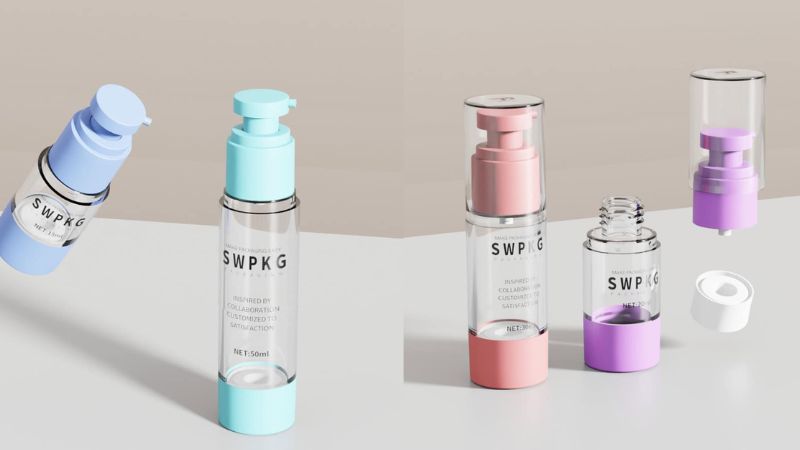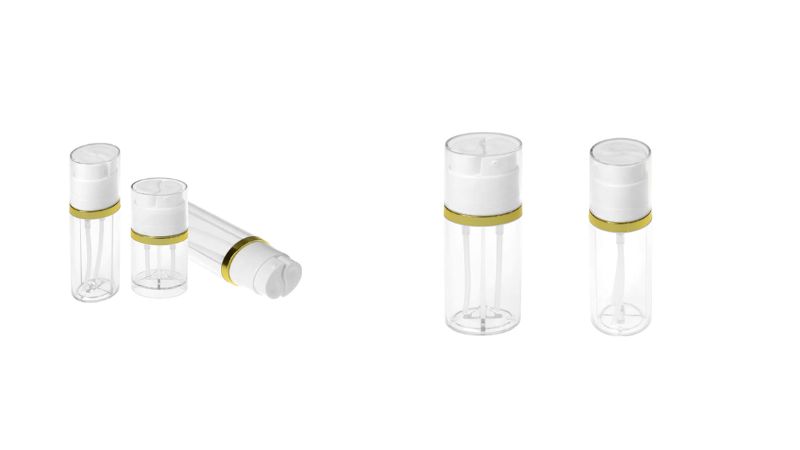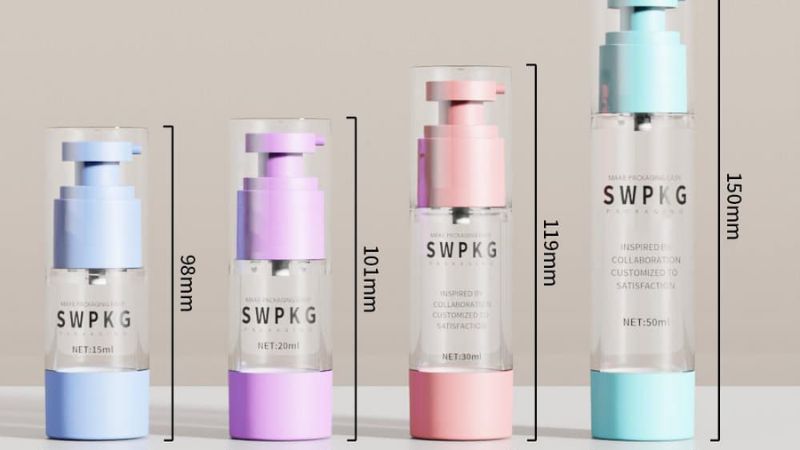Airless pump technology changed the game in beauty and personal care packaging and it’s designed to keep your products fresher and more effective for longer.
These innovative dispensers work without letting any air inside the bottle which means no oxidation no bacteria and no messy residue. It’s a small change with a big impact on both product quality and your daily routine.
What are Airless Pump Bottles?
Airless pump bottles are cosmetic containers that dispense products without letting air inside.
Parts of Airless Pump Packaging

Base
The base forms the bottom of the container and provides stability for the entire packaging system. It supports the piston mechanism and ensures the bottle stands upright during use and storage.
Piston
The piston sits inside the container and moves upward as you dispense the product. This movement creates a vacuum that pushes the formulation out without allowing air to enter, preserving your skincare products’ effectiveness and preventing oxidation.
Pump
The pump mechanism replaces traditional dip tubes and controls product dispensing through vacuum-driven action. It delivers precise amounts of product with each use while maintaining hygienic isolation from external air, reducing contamination risk and minimizing waste.
What is Airless Pump Technology?
Airless pump technology uses a vacuum system to dispense product without letting air enter the container.
A piston rises as you pump, pushing the formula upward through a one-way valve. This mechanism prevents oxidation, reduces bacterial growth, and eliminates product waste. You get a precise dose every time, and the packaging stays clean and residue-free.
Popular Airless Technology
- Bag-on-valve systems use a collapsible bag inside a pressurized canister for dispensing.
- Piston-driven pumps rely on a mechanical lift system activated by user pressure.
- Membrane-based designs incorporate a flexible barrier that moves as product dispenses.
- Spring mechanisms use internal coil springs to push product upward consistently.
Benefits of Airless Pump Technology

Complete Product Dispensing
Airless pumps dispense nearly 100% of your product, eliminating waste and ensuring you use every last drop. You don’t need to shake or dig out residue, as the internal disc rises and pushes out the formula completely.
Improved Shelf Life
Airless technology prevents air exposure, reducing oxidation and degradation of active ingredients. Your products maintain their potency longer, extending their effective shelf life significantly.
Hygienic and Tamper-Resistant
The sealed system keeps your product safe from contamination, since it never touches outside air or your fingers. You get a tamper-resistant package that ensures formula stability and safety.
Consistent and Controlled Dosing
Airless pumps deliver uniform, metered doses with each use, giving you precise application every time. You avoid overuse or spillage, making your skincare routine more efficient.
Preserves Sensitive Ingredients
Sensitive ingredients like Vitamin C benefit from opaque, airless packaging that prevents oxidation. You maintain the clinical effectiveness of preservative-free formulas without compromise.
| Benefit | Impact on Product Use |
|---|---|
| Complete Product Dispensing | Reduces waste by dispensing nearly 100% of the product |
| Improved Shelf Life | Extends potency by limiting oxidation |
| Hygienic Design | Prevents contamination from air or contact |
| Consistent Dosing | Provides uniform, precise application |
| Ingredient Preservation | Protects sensitive actives like Vitamin C |
The Best Products to Package with Airless Pumps
Skincare Products with Sensitive Actives
- Retinol creams maintain potency without air-induced degradation.
- Vitamin C serums stay effective by avoiding oxidation.
- Peptide formulations remain stable and contamination-free.
Serums and Facial Creams
- Anti-aging creams dispense hygienically with zero finger contact.
- Hydrating serums deliver exact doses without over-application.
- Brightening treatments stay fresh until the last drop.
Hair Care Formulations
- Scalp treatments remain sterile and bacteria-free.
- Leave-in conditioners resist oxidation and separation.
- Growth serums preserve active ingredients for consistent results.
Eye Treatments
- Under-eye creams stay sanitary with airtight protection.
- Lash serums avoid contamination with precise, airless dispensing.
- Dark circle correctors maintain formula integrity throughout use.
High-End Cosmetics
- Luxury face creams offer premium preservation and elegant dosing.
- Premium foundations stay fresh with UV and air protection.
- Exclusive serums provide extended shelf life and reduced waste.
Trends in Airless Pump Bottles

Dual Chamber Design
It is an innovative solution that allows for the separate storage of two different products. This design is particularly beneficial for combining two formulas at the time of application.
Personalized Packaging
The design trend for airless bottles is moving towards customization, allowing users to choose from various colors, patterns, and engravings to enhance aesthetic appeal and personal connection. If you have the customization ideas, contact somewang.
Double-Layer Design
The double-layer design, for example, with a transparent outer layer and a solid-colored inner layer, is gaining popularity. The outer layer can have simple lines or patterns, highlighting the inner layer’s bold colors. This trend boosts visual appeal and offers brands innovative ways to express identity and attract consumers.
Transparent Product Visibility
The design of transparent or semi-transparent bottles is becoming increasingly popular in the market. Users can visually see the product’s color and remaining quantity, helping them make the right choices when purchasing.
Frequently Asked Questions
What is airless pump technology?
Airless pump technology is a dispensing system that prevents air from entering the container, protecting the product from oxidation, contamination, and degradation. It uses a vacuum mechanism to push the formula out without relying on air pressure. This helps maintain the product’s effectiveness and extends its shelf life.
How does an airless pump work?
When you press the pump, a piston inside rises, creating a vacuum that pushes the product upward through a one-way valve. This mechanism dispenses the formula without letting air in, ensuring precise, hygienic, and residue-free application every time.
What are the benefits of airless pump packaging?
Airless pumps offer five key benefits: complete product dispensing (no waste), extended shelf life by reducing oxidation, hygienic and tamper-resistant use, consistent and controlled dosing, and protection for sensitive ingredients like Vitamin C and retinol.
Do airless pumps really improve product shelf life?
Yes. By blocking air exposure, airless pumps prevent oxidation and bacterial growth, which helps maintain the potency of active ingredients. This significantly extends the product’s effective shelf life and ensures it stays fresh and effective until the last use.
How do airless pumps compare to regular pumps?
Unlike regular pumps that use a dip tube and allow air inside, airless pumps operate via a vacuum-sealed system. This design prevents air contact, reduces contamination risk, eliminates product waste, and provides more precise dosing compared to traditional dispensers.
